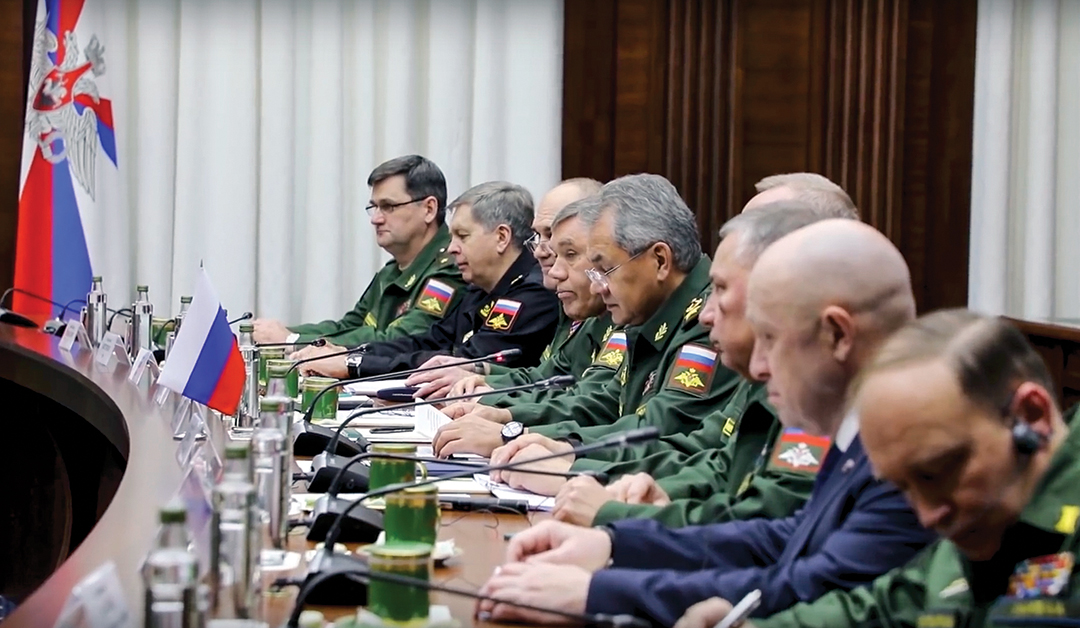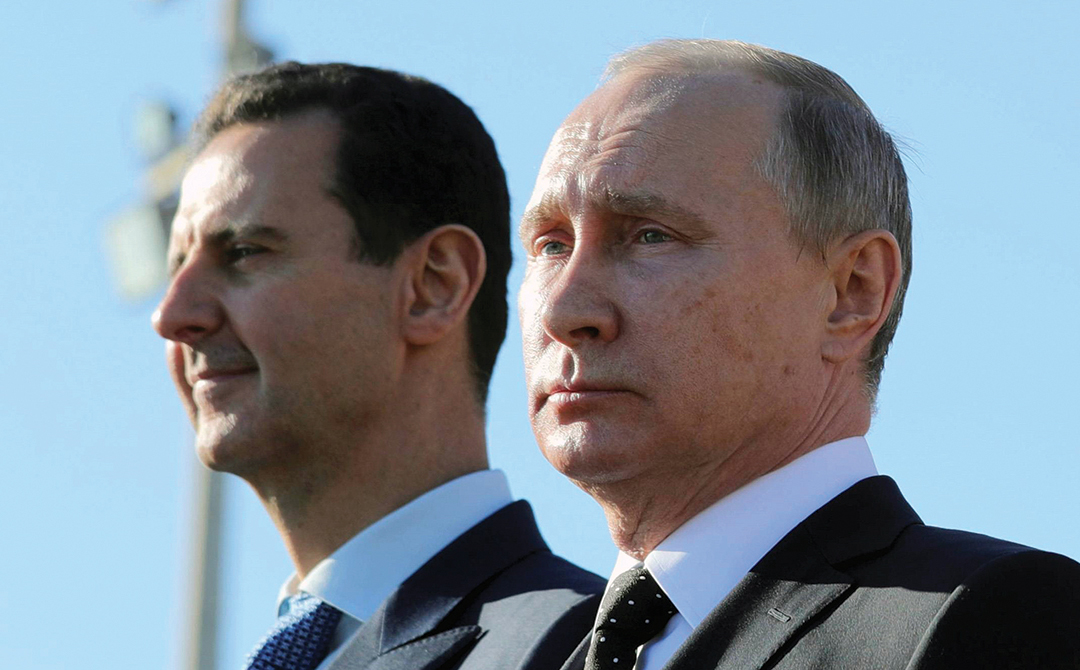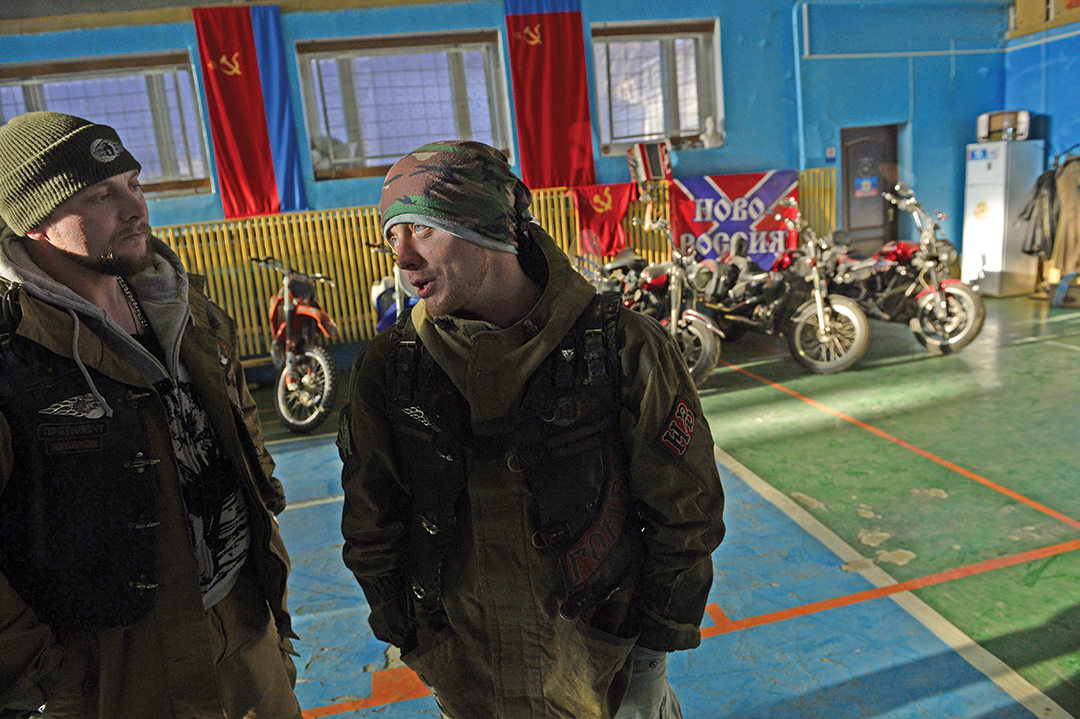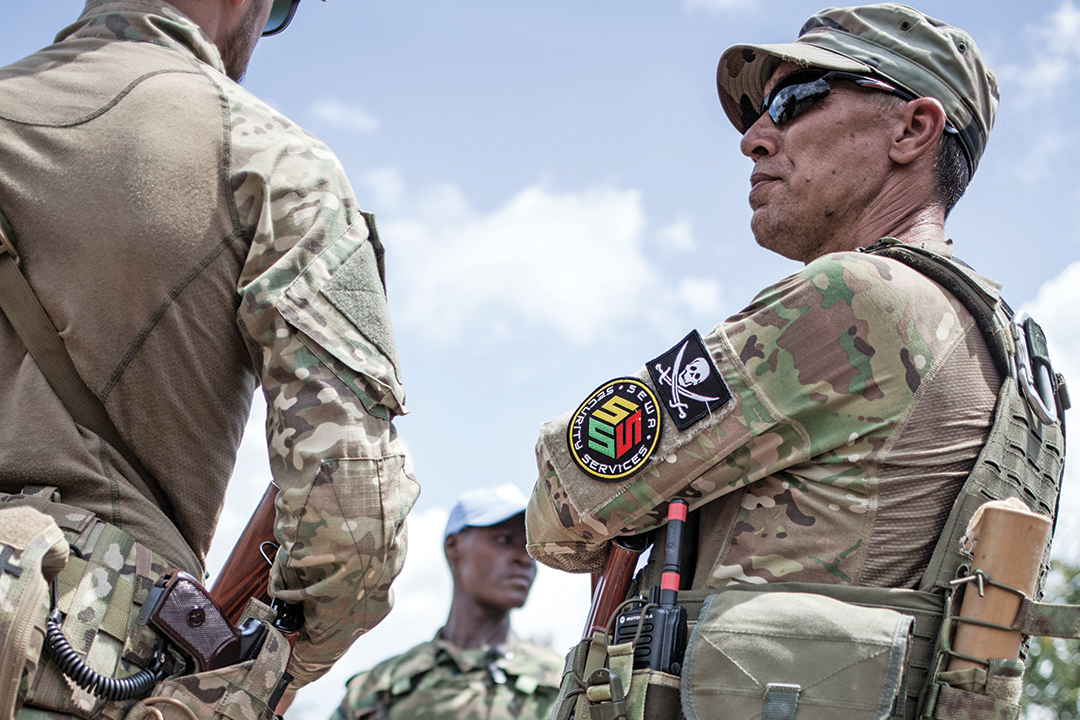Using Covert Forces to Wage Hybrid Warfare
By Dr. Cyprian Aleksander Kozera, assistant professor, War Studies University, Warsaw
The world witnessed Russia’s diversionary, or hybrid, warfare in 2014 with the invasions of Crimea and Donbas. Such warfare relies heavily on an element that has been largely overlooked by great power competition-focused strategists: proxy forces, which are actors outsourced to supplement or help the patron achieve its goals.
Proxies of various kinds increasingly populate the contemporary battlespace, and by providing plausible deniability, they help realize the military, political and strategic interests of their patrons. Proxy forces fit very well within the “doctrine” named for Gen. Valery Gerasimov, chief of the general staff of the Russian Armed Forces. The doctrine, which is Moscow’s en vogue approach to waging armed conflict, is characterized by covert use of force and indirect, asymmetric warfare.
Instead of employing ready-to-use proxies, the decision-makers in Moscow may create their own by proxying special operations forces (SOF) and labeling them as “little green men.” These unmarked combatants are always at hand to support local self-determination movements that incidentally coincide with Moscow’s geostrategic schemes. In addition, Russian quasi-state private military companies (PMCs) have emerged, composed of former Russian intelligence (GRU, FSB) agents who are sent to conflict zones in the Central African Republic (CAR), Libya, Syria and elsewhere in furtherance of Moscow’s policies. They provide military know-how to troubled politicians and warlords, protect them, support them with propaganda and disinformation, help win rigged elections, and offer extraction of their natural resources — an offer one cannot refuse if one needs Russian support.

Russia’s use of proxies is a political game in uncharted territories, where global international norms do not yet reach and where one can profit from buccaneer-style politics, make short-term strategic gains and still deny any involvement — all while the West debates how high the threshold is for war.
Still Warfare, By Any Name
Poland, which had the second-largest army in the Warsaw Pact, changed camps in 1999 as part of NATO’s eastward expansion, which put NATO on Russia’s borders via the Kaliningrad enclave. Additional NATO enlargement in 2004 that incorporated the Baltic states of Estonia, Latvia and Lithuania into the Alliance only reinforced for Russia the loss of its traditional sphere of influence. With its NATO nemesis expanding east into regions that previously had been occupied by imperial Russia since at least the 18th century, Moscow, the titan with feet of clay, felt surrounded and threatened.
The short-lived, post-Cold-War era of Russia playing the role of the jovial bear, personified by Boris Yeltsin, was over when ex-KGB spy Vladimir Putin claimed the czarist throne in 2000. Under his presidency, not-so-old Cold War fears and imperial ambitions returned to the Kremlin. Putin believed that Russia was under threat on all fronts. A 2003 Kremlin white paper clearly showed this change in perception: The Russian motherland was yet again vitally endangered, and Moscow needed to counterattack. And the Kremlin needed a new approach to war — one that would not lead to an open confrontation that Russia would surely lose because its weakened and obsolete military could, at that time, barely handle even the separatist rebellion in Chechnya.
In 2013, alarmed by the developments of the Arab Spring, Gerasimov published an article in The Military-Industrial Courier in which he advocated for asymmetric, indirect and concealed methods of war, or rather subversion, that would encompass diplomatic, economic, political and (preferably covert) military tools (paramilitary and special forces). Under this method, the regular army, if it is to be used at all, should be employed only in the final stages of a conflict and possibly under the guise of peacekeepers. Gerasimov dubbed this invisible but deadly subversive warfare “new generation warfare.”
In fact, there is nothing revolutionary in the concept: Deception and camouflaged warfare (maskirovka) were already employed by Russia in World War II. Gerasimov just skillfully poured old wine into new bottles. Such hybrid methods were already used by the Soviets during a failed coup d’état in Estonia in 1924, when they employed a mix of unmarked soldiers, local agents and the threat of external intervention. Similar patterns were used in the first phase of the Winter War in Finland (1939); in Afghanistan (1979), which was inaugurated by 700 Russian special forces infiltrating the country in Afghan uniforms; and in the Second Chechen War (1999-2009), where Russia used a local proxy force — the Vostok Battalion.
Sergei Chekinov and Sergei Bogdanov further developed the concept. They took from the first Gulf War the idea of network-centrism and applied it to Russian tactics with striking effectiveness. The new-generation warfare was to be centrally controlled and integrated to simultaneously, or consecutively, implement all possible tools to weaken the enemy, including propaganda campaigns, undermining state institutions (e.g., by corrupting officials), increasing social tensions (e.g., by funding radical movements), using electronic warfare, supporting local subversive movements and insurgencies, and using sabotage and terrorism. Conventional military power was to be employed selectively and from a distance, with aerial precision strikes and long-range missiles. The idea was to create enough “fog of war” to invisibly weaken the enemy, while remaining far below the threshold of war and thus any possible forceful response.

Gerasimov’s new-generation warfare theory was put into practice in 2014, less than a year after he introduced it, with the occupation of Crimea and armed conflict in eastern Ukraine. The West reluctantly admitted that this was indeed a war — a Russian-led war — and called it hybrid warfare because it mixed the regular armed forces with irregular units, conventional methods with nonconventional tools, and public denial with hidden support. In fact, this was not only hybrid, but rather full-spectrum warfare, implementing whatever works in every possible field with striking efficiency.
Whether it’s called hybrid, diversionary, deceptive, new-generation, nonlinear or full-spectrum, it’s still warfare.
Outsourcing Warfare: Proxies on the Battlefield
Within this full-spectrum warfare, proxy forces find their special place. They are third parties, used as a supplementary means of waging war or as a substitute for the direct and open employment of a state’s army. Such outsourcing of warfare fits well within Gerasimov’s doctrine because proxies such as paramilitary units or insurgents are used indirectly, providing plausible deniability for the patron in Moscow.
Yet, with proxy forces it is not only about the deniability. The lack of boots-on-the-ground engagement by a state’s own troops drastically reduces the costs, economic and political, domestic and international. Outsourcing of warfare to proxy actors means that the state budget will not be burdened by more costly official troop deployments, soldiers’ parents will not bother the government for accountability of casualties, and the international community pays less attention to minor clashes involving nonstate groups in remote regions of the world. Thus, optimally, use of proxy actors stalls the international community’s and the adversary’s responses while quick strategic gains are made. In a nearly invisible war, once the foe realizes it is under attack, the conflict can be suspended and political actions can preserve the new status quo. Such a premeditated strategy, that in its protracted political stage can last for years, bleeds the opponent’s economy and morale, and precludes opportunities to join international alliances that generally do not admit states engaged in military or political conflicts. When nonstate actors can become proxies at such a low cost, strategic gains can be unproportionally high. In less ambitious scenarios, proxy forces can be surrogates to do jobs the government is not willing or cannot afford to undertake due to international commitments, lack of technical capacity (e.g., overseas deployments) or moral considerations. Furthermore, as in the Cold War, proxies are used where a global power fears confrontation and escalation with another global power. Thus, proxy forces are playing an increasingly significant role in the contemporary battlespace.
Globally, Iran, Turkey and Russia are the main protagonists of proxy warfare. Yet, with close scrutiny, one can find in every conflict an armed group, or even a local army, that serves as an auxiliary, partner or facilitator to a larger actor. Hezbollah, which is an armed group, a political party and a state within a state, has benefited from the support of Teheran and Damascus and helps realize Iranian and Syrian interests in Lebanon, Syria and Iraq. The Kurdish-dominated Syrian Democratic Forces have been supported by the U.S., while in the same Syrian conflict, another NATO country, Turkey, supports the Free Syrian Army that consists of units hostile to the Kurds. In the same battlespace, Russia favors the Bashar Assad regime and dispatched some of its PMCs to serve Moscow’s and Damascus’s common interests.

For obvious reasons, Russia and Iran would not openly and directly challenge the U.S. on the battlefield, but supporting their own proxies in the fight against U.S. proxies is a different thing. Similarly, Turkey, as a U.S. ally and a NATO member, hesitates to act openly against U.S. interests, yet they are willing to combat U.S.-backed nonstate actors. In the complicated Syrian battlespace, the proxies allow the pursuit of national interests on the tactical and operational level, with a touch of plausible deniability, lower risk of escalation and in accordance with primary strategic alliances.
However, the academic definitions of proxies are not clear-cut and often depend on one’s perspective and assumptions. Some may argue that in the U.S. war against the Taliban, the Afghan Army served as a U.S. proxy (despite having its own obvious interests). From such a perspective — had Afghanistan been prioritizing U.S. goals rather than its own — Kabul could indeed have been considered a U.S. proxy. Yet, this would have undermined the Afghan government’s independence and legitimacy and would not have squared with reality. Let us therefore not generalize too broadly and understand proxy forces as nonstate groups that are employed by a state (the patron) in the battlespace, in pursuit of the patron’s interests.
New-Generation Warfare: Ukraine
At the beginning of 2014, Putin’s support ratings were at a historic low. At the same time, the Ukrainian people, demanding closer ties with the European Union, ousted pro-Russian Ukrainian President Viktor Yanukovych on February 22 amid a massive outbreak of popular unrest in Kyiv. The eastern, Russian-speaking regions of the country, where there is a substantial Russian minority and some nostalgia for Soviet times, were reluctant to accept the new order. Russia had already threatened in 2013 that any attempt to establish closer ties with the West would result in Ukraine’s fall. Acting opportunistically and profiting from the chaos, Moscow plunged its neighbor into an ongoing conflict that has shackled its hopes of joining the EU and NATO.
On February 27, Russian soldiers wearing Ukrainian special police (Berkut) uniforms seized key checkpoints on the way to Crimea. The following day, the so-called little green men, claiming to be local self-defense forces, emerged around Crimean airports and seized control of these strategic places. Thus started the Russian intervention that illegally incorporated the Crimean Peninsula into Russia and subsequently (in March 2014) sparked another conflict in Ukraine’s eastern Donetsk and Luhansk provinces, commonly known as the Donbas region.
For allegedly ad hoc, local, self-defense militias, the little green men were very well trained and equipped with modern Russian gear, weapons and uniforms. All they lacked were identifying national and military insignia. Putin initially denied Russian involvement, commenting: “There are many military uniforms. Go into any shop and you can find one.” He kept up this denial for two months — long enough to stall any response from those in the international community that were unwilling or too bewildered to act.
Alongside these oft-called “polite people” from Russian special forces, other Russian proxies emerged locally or were installed by Moscow: PMCs, such as the Wagner Group and the Vostok Battalion, which are closely linked to the Russian government and consist of former SOF and intelligence service members; paramilitary groups such as the Night Wolves Motorcycle Club; religious-nationalist groups such as the E.N.O.T. Corporation (also a PMC); organized crime groups; local volunteers; and corrupt Ukrainian military and security personnel. The professionally armed green men took over strategic locations such as military bases and airports, while the paramilitaries took control of less protected strategic infrastructure and key administrative institutions.

By April 17, Putin admitted Russia’s military presence in Crimea, claiming it was to protect local Russian populations, yet he continued to deny direct Russian interference in the Donbas. Despite such denials, the “separatists” in some areas of Donbas were predominantly Russian agents and contractors. In others, they were local elements, mostly of criminal character, supported and led by Russians. What is beyond doubt, however: The insurgents were equipped and directed by Moscow.
The most tragic testimony to that is the MH-17 incident. A Malaysia Airlines flight from Amsterdam to Kuala Lumpur was shot down over eastern Ukraine on July 17, 2014, by a separatist-operated Russian “Buk” surface-to-air missile, killing all 298 people onboard. An investigation found that the missile launcher had come from the Russian 53rd Anti-Aircraft Missile Brigade and had crossed the Russia-Ukraine border into separatist-controlled territory a few days earlier. Russia continued to deny responsibility and changed its versions of the events many times, spreading disinformation and blaming the Ukrainian Army for shooting down the plane and the Ukrainian government for allowing it to overfly a war zone in the first place.
The irrefutable proof, however, pointed to Russian heavy weaponry crossing the border at will to arm a hybrid separatist force consisting of foreign Russian agents, contractors, volunteers, and local adventurers and criminals. Proxied, unmarked Russian SOF and other actors played key roles in the first phases of the Ukrainian conflict, while regular Russian troops mostly watched from across the border and provided equipment. The solid social base provided by the substantial ethnic Russian population in Crimea and Donbas facilitated these tactics, making introduction of the supposedly local self-defense forces and the drafting of indigenous volunteers much easier.
Beyond the Post-Soviet Space: Syria and Libya
To counter U.S. influence in the Middle East, Russia must be present there. One of the main reasons for Russia’s involvement in the Syrian conflict was to defend its last foothold in the eastern Mediterranean — Syria, and specifically the Tartus naval facility. Were the Assad regime to fall, Russia could lose this strategic installation and thus its ability to replenish and repair its naval assets on the Mediterranean. Furthermore, it would also mean Moscow losing its last ally in the region. Tartus is a Russian Alamo — without this foothold, its global ambitions would be deeply hurt. Russia may be interested in Libya for the same reasons. Moscow is backing Khalifa Hifter of the Libyan National Army (LNA). Hifter could become a new ally in the region, providing Russia with a military base in North Africa and thus a footing on the EU/NATO southern flank.
In both conflicts, Russian assets were employed with similar restraint. In Syria, Moscow provided military advisors and equipment, but was also keen to use its air component and SOF against Islamic State targets on the ground. The PMCs (mainly the Wagner Group, but probably also Cossacks, E.N.O.T., the Slavonic Corps, ATK Group, MS Group and Centre R) were present and worked closely with the Russian military. The February 7, 2018, battle near Deir al-Zour between U.S.-led forces and a “pro-regime force” testifies to the size of their presence in the Syrian conflict zone. An American-Syrian Democratic Forces joint base was attacked by over 500 troops and 27 vehicles, including Russian-made T-72 tanks. Most of the attacking force were Russian mercenaries, but the Russian high command in Syria denied any involvement. The pro-regime force reported casualties of 200-300 and Russia disingenuously admitted to losing four Russian citizens there, but estimates of the actual losses are much higher.
In Libya, Russian engagement was more limited and a seemingly more refined, proxy-based warfare. Air assets (Mig-29 and Su-24 fighters) were also sent to Libya to support Hifter’s LNA offensive and piloted by Russians. Gen. Stephen Townsend, commander of U.S. Africa Command, said: “That will be Russian mercenary pilots flying Russian-supplied aircraft to bomb Libyans.” Since piloting fighter jets requires sophisticated training, they could not have been flown by local mercenaries. Either they were Russian Air Force pilots sent as advisors or former Russian military hired by a Russian PMC operating in Libya, such as the Wagner Group or RSB-Group. Wagner, the most infamous Russian mercenary company, has been present on the ground in Libya in a strength of 1,200-2,000 men from Russia, Serbia and eastern Ukraine. They are stationed on Jufra Air Base and Ghardabiya Air Base in Sirte, on the central Libyan coast. Due to a shortage of fighters, some are being sent from other conflict theatres, mainly Syria. Col. Alexander Zorin, a former Russian Defense Ministry envoy to Geneva, was reportedly responsible for recruiting mercenaries in southern Syria, offering $1,000 for a fighter and $5,000 for a commander, and guaranteeing amnesty from prosecution by the Syrian regime (e.g., for fleeing the draft).
Russia’s involvement in conflicts in the Middle East-North Africa region is proxy-heavy, allowing Moscow to evade the economic and political costs of deploying an army. Beyond that, the Russian presence relies heavily on SOF and air assets (fighter jets and unmanned aerial vehicles). Due to the increasing use of proxy actors and drones in Libya, some consider this conflict to reflect the future nature of warfare.
Russia in the CAR: Back in Business
Moscow completely abandoned its significant presence in Sub-Saharan Africa after the fall of the Soviet Union. In recent years, with the Kremlin’s growing ambitions, Russia is making a comeback in Africa, but with more shadowy methods. When offering military assistance and hardware to African leaders (Burundi, the Democratic Republic of the Congo, Madagascar, Mozambique, Sudan), Moscow does not interfere nor inquire about national politics. In some countries, Russian disinformation and election-meddling expertise is sought. In others, military know-how and mercenaries are requested.
In the war-torn CAR, Moscow conducts an official military advisory mission with army instructors in Bangui. In addition, the Kremlin sent “civilian” instructors from the Wagner Group and Sewa Security Services PMCs to protect President Faustin-Archange Touadéra and his regime. In exchange, the Russians took over the palace of former self-proclaimed CAR emperor, Jean-Bédel Bokassa, in Berengo, and most important, signed contracts to extract precious resources, including gold and diamonds but possibly also oil and uranium. The owner of the Wagner Group, Yevgeny Prigozhin (a close Putin associate and his former chef), also owns M Invest, which secured the contracts. With the mines located in the northeastern territories held by former Séléka rebels, the Russians have a stake in peacekeeping and negotiated solutions. Yet, being also vitally interested in the Touadéra regime’s survival, the Wagner Group has seen combat, assisting in April 2021 in recapturing the key cattle-market city of Kaga-Bandoro.
Despite Prigozhin’s business interests, Moscow’s presence in this pays du champ (former French colony) is important to rebuilding its great power ambitions. Interestingly, after recent deals with Togo and the Republic of the Congo, Russia has been called upon by Mali after France declared that it is reducing its military counterterrorism commitment in the Sahel. The Russians have already been tempted into providing counterterrorism assistance in Mozambique, but the harsh, tropical conditions and warfare proved too difficult for the Wagner Group’s Eastern European mercenaries. Not every Russian undertaking has been successful, yet overall, Russia is increasing its presence in Africa at the expense of the West. However, having a limited financial capacity, Moscow is not interested in establishing permanent military bases and focuses on a hybrid presence: legal and official advisors and shadowy PMCs.
The Global Proxy Game
Kremlin proxies of various affiliations have been seen in the most remote places of the globe, ranging from Venezuela to the CAR to Iraq. Despite different brand names, they hail from similar sources — Russian intelligence agencies and special operations units — and are being closely controlled by the Kremlin despite posing for the outside world as PMCs. When necessary, Russian active-duty SOF soldiers may be relabeled as little green men and pose as local militias or militaries. Such ad hoc “proxying” of Russian military forces does not pose any ethical or legal problem to Moscow, which readily employs the “whatever works” approach in disregard of international laws and norms.
Russian PMCs offer a wide range of services: protection and combat (Prigozhin’s Wagner Group), disinformation (Prigozhin’s Internet Research Agency, dubbed the “Troll Factory”) and resource extraction (Prigozhin’s M Invest). Yet, in a hybrid state such as Russia, nothing is realized without the blessing and knowledge of the supreme leader — Putin, who once famously referred to proxy actors as an “instrument for realizing national interests without the direct participation of the government.” And this is precisely the strategy of the Kremlin — to limit the participation of and costs to the government while still pursuing its interests.
For Moscow, the nonlinear warfare and proxy-based approach works: Ukraine, with an ongoing conflict in the east, is hampered from entering the Western clubs; Assad is saved and sits well in Damascus; and the French presence in Africa is being replaced with a Russian one (Moscow’s trade exchange with African nations rose from $3.4 billion in 2015 to $14.5 billion in 2018). Despite lacking full operational control over its proxies, especially in complicated theaters such as Ukraine, and facing intergroup rivalries on the ground, nonstate-actor-based warfare has proved to be highly efficient, especially when tailored to local conditions. Hence, it has become part of Moscow’s strategic culture. Proxies are here to stay.


Comments are closed.